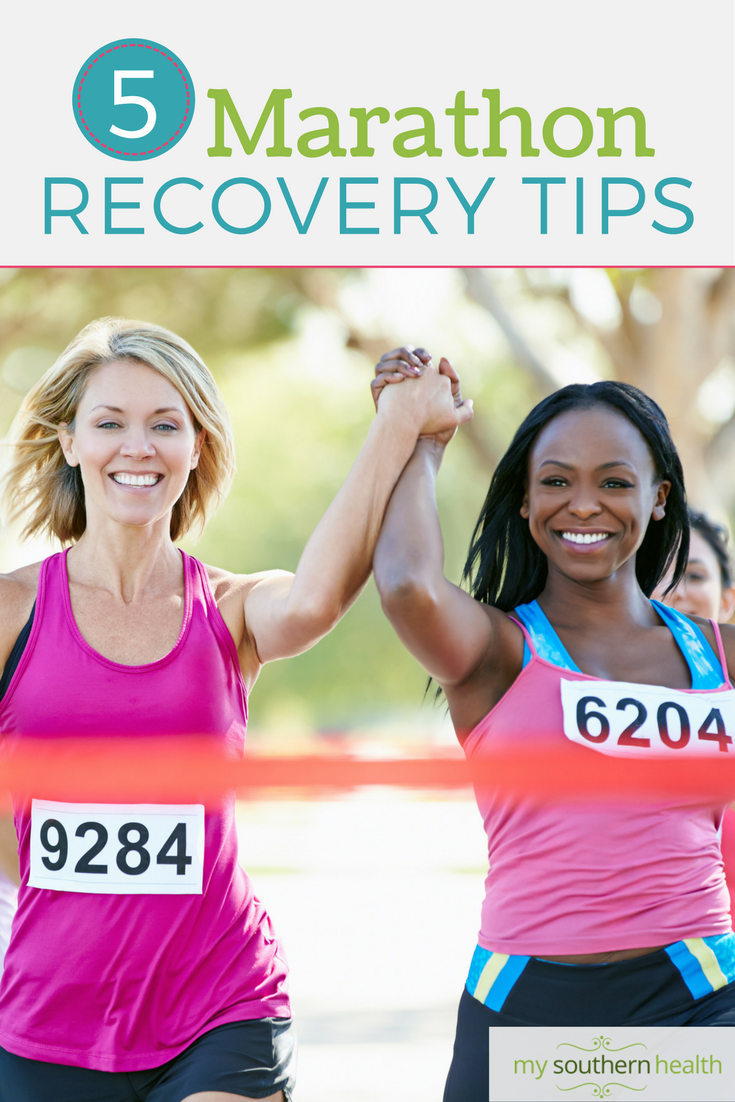Use this five-part marathon recovery plan after finishing your next big race.
Whether it is your very first marathon or your 30th, that feeling of the runner’s high that you experience as you cross the finish line typically gives way to tiredness, stiffness and some pain that come from logging 26 miles. It is important to remember that marathon recovery is part of a good training plan; it is imperative to injury prevention and a strong return to running. By following these tips, both marathon and half-marathon runners can significantly speed recovery.
1. Refuel and rehydrate.
Recovering from a marathon begins the minute you step across the finish line. Research from the American College of Sports Medicine suggests that refueling works best if done immediately after exercise, when the body is eager to absorb energy. Re-fueling will help you replenish glycogen stores used during the workout; optimize protein synthesis to repair damaged muscle tissue and stimulate the development of new tissue; and replace fluids and electrolytes that were lost in sweat.
Jessica Bennett, a Vanderbilt registered dietitian and certified personal trainer, says, “With all the excitement that comes with finishing a race, it can be difficult to remember the importance of refueling and rehydrating your body that just worked so hard to accomplish a great finish. It’s important to refuel by getting a protein and a carbohydrate within 30 minutes after your run to take advantage of the prime time for muscle rebuilding/recovery. Make sure to immediately drink water or sports drinks to start hydrating before having a celebratory alcoholic beverage.”
Your go-to marathon recovery foods should provide protein and carbohydrates to rebuild and replenish. Examples of good protein sources are low-fat chocolate milk, peanut butter on whole-grain bread and boiled eggs. Good post-race carbohydrate sources include bananas, oatmeal and bagels.
Consult with a registered dietitian for a personalized sports nutrition plan.
2. Get a massage.
Massage is widely believed to enhance muscle recovery after intense exercise, even though scientific evidence is lacking, says Rebecca Dickinson, clinical coordinator of Vanderbilt Sports Medicine Rehabilitation. “The scientific evidence regarding the effect of massage on muscle recovery, swelling and soreness is inconclusive. However, there may be psychological benefits that shouldn’t be overlooked. Individuals do report that massage does appear to positively influence perceptions of recovery.”
If you don’t want to invest in the cost of a professional massage, which can typically run about $60-$80 for a one-hour session, try self-massage with a foam roller. A roller, which looks like a firm log, can be a valuable part of a runner’s routine. Foam rollers range in price from around $20-$50 and most gyms’ fitness staff can show you how to use your foam roller effectively.
3. Soak in a cool bathtub.
You don’t need to take an ice bath to get the benefits. Taking a cool water bath is an efficient way to reduce inflammation and soreness in your entire body. Although it may not be totally enjoyable, wearing clothing or drinking a hot drink while you soak helps some runners. If you can’t handle the cold tub, try topically applying ice packs to sore area to help reduce inflammation and soreness.
4. Cross train.
Many running experts recommend waiting several days before beginning even running a few miles. When you do start back to running a bit, as most runners get the itch to do after a few days, it is a great time to also consider trying some cross training.
Low-impact options like swimming, biking or yoga are great choices, but some simple walking or hiking is perfect for recovery workouts to get the blood flowing and the muscles moving. Slowly reintroduce running back into your training schedule over the next few weeks to give your body a break both physically and mentally. Keep in mind that another important part of recovering is to give your mind a break from the focus of training, so when your body is recovered, you will have the mental energy you need, too.
5. Sleep.
It is crucial to get plenty of sleep when you’re recovering from a marathon. Sleep is one of the most effective ways we heal our bodies, so allow yourself the indulgence of sleeping in a bit and napping when you can. Chances are that if you have been training for your marathon for months, you have been rising early to get started with your mileage. So, treat yourself to a bit more shut-eye over the first few weeks after your race and consider it part of your training recovery plan that will allow you to heal and come back stronger.
Good luck, and remember, proper recovery means the opportunity to compete and train in the future. An injury means watching from the sidelines. So take time to recover properly and you can expect to feel great soon and be planning your next race soon.
Stacey Kendrick, MS, is a health educator with more than 20 years of experience in wellness and population health. She spent much of her career at Vanderbilt’s Faculty/Staff Wellness Program and currently works in Strategic Marketing at Vanderbilt. She is mother to two adult daughters. In her free time, she teaches healthy cooking classes, runs, gardens and enjoys backyard bonfires.


